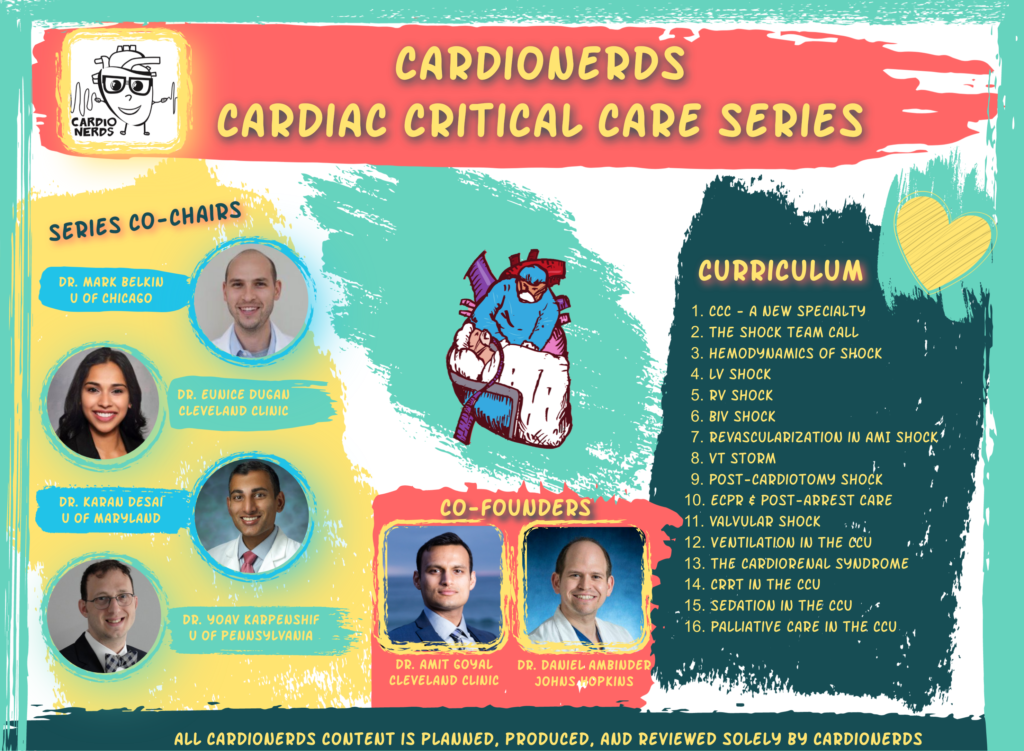
177. CCC: Cardiac Arrest, E-CPR, & Post-Arrest Care with Dr. Jason Bartos
Cardionerds: A Cardiology Podcast
Coronery and the Role of Cd in Post-Ross Coronary Interventions
The role of c d in carticores with nautical rhythms is not completely known. The role or timing of revatrization post rossing patients without a stemi or shock, is unclear. We will have a dedicated episode on cornary rvascularization and cartiogenic shock later in this series.
Approximately 350,000 adults per year in the US experienced out-of-hospital cardiac arrest (OHCA). Only about 10% of such patients survive their initial hospitalization. The key drivers of successful resuscitation from OHCA are bystander cardiopulmonary resuscitation (CPR) and public use of an automated external defibrillator (AED). Survival rates from OHCA vary dramatically between US regions. For instance, the extracorporeal CPR (eCPR) program at the University of Minnesota has over a 40% survival rate in patients with OHCA and refractory ventricular fibrillation (VF) based on data published in the ARREST trial. In this episode, we are joined by experts from the University of Minnesota, including Dr. Jason Bartos (Interventional and Critical Care Faculty) and Dr. Julie Power (Chief Fellow at University of Minnesota and CardioNerds Academy Fellow), along with Dr. Yoav Karpenshif (Co-Chair Critical Care Series, University of Pennsylvania) and CardioNerds Co-Founders (Amit Goyal and Dan Ambinder) to discuss cardiac arrest, E-CPR, & post-arrest care. This includes targeted temperature management, coronary angiography and revascularization, as well as the growing field of eCPR and VA ECMO. Episode introduction by CardioNerds Clinical Trialist Dr. Jason Feinman. Audio editing by CardioNerds Academy Intern, Shivani Reddy.
The CardioNerds Cardiac Critical Care Series is a multi-institutional collaboration made possible by contributions of stellar fellow leads and expert faculty from several programs, led by series co-chairs, Dr. Mark Belkin, Dr. Eunice Dugan, Dr. Karan Desai, and Dr. Yoav Karpenshif.
Claim free CME for enjoying this episode! Disclosures: None
Pearls • Notes • References • Guest Profiles • Production Team

Abbreviations – Cardiac Arrest, E-CPR, & Post-Arrest Care
eCPR- extracorporeal cardiopulmonary resuscitation
VA ECMO- veno-arterial extracorporeal membrane oxygenation
VT/VF- ventricular tachycardia/ventricular fibrillation
ACLS- advanced cardiovascular life support
ROSC- return of spontaneous circulation-
OHCA- out-of-hospital cardiac arrest
IHCA- in-hospital cardiac arrest
TTM- targeted temperature management
Pearls and Quotes – Cardiac Arrest, E-CPR, & Post-Arrest Care
- The ARREST trial showed early VA ECMO-facilitated resuscitation for patients with OHCA and refractory VF significantly improved survival to hospital discharge when compared to standard ACLS treatment.
- Coronary artery disease is common in the setting of cardiac arrest, with up to 96% of patients with STEMI on post resuscitation EKG and up to 85% of refractory out-of-hospital VT/VF arrests.
- Guidelines recommend emergent coronary angiography for patients with ST-segment elevation on the post-ROSC ECG.
- The role of timing of revascularization after ROSC in patients without STEMI or shock is unknown.
- The role of coronary angiography in cardiac arrest with nonshockable rhythms is also unclear.
- The current AHA guidelines recommend initiation of targeted temperature management between 32°C and 36°C for at least 24 hours for all patients who do not follow commands after ROSC in both OHCA and IHCA.
Show notes – Cardiac Arrest, E-CPR, & Post-Arrest Care
1. What are early post arrest management considerations?
- The key drivers of successful resuscitations from OHCA: CPR and public use of AEDs in the field. After initial stabilization, care of the critically ill post-arrest patient hinges on hemodynamic support, mechanical ventilation, temperature management, attending to adverse sequelae of arrest, and diagnosis and treatment of underlying causes of arrest.
- Coronary artery disease is common in the setting of VT/VF cardiac arrest, with up to 96% of patients with STEMI on post resuscitation EKG and up to 85% of refractory out-of-hospital VT/VF arrests.
- In the early post-arrest state, it is also important to diagnose and treat infections and any neurologic injury. Neurologic compromise is a common cause of mortality in patients who achieve ROSC. Over 50%, and in some cohorts around 75%, of patients with death after resuscitated OHCA die of neurologic injury.
2. What is the current evidence for targeted temperature management (TTM)?
- “[This is] the most hotly debated topic right now in the field of cardiac arrest.” – Dr. Jason Bartos
- Current AHA guidelines recommend initiation of targeted temperature management between 32°C and 36°C for at least 24 hours for all patients who do not follow commands after ROSC in both OHCA and IHCA. TTM is a relatively safe and effective strategy that can improve neurological outcomes in patients who remain comatose after achieving ROSC from cardiac arrest. Current evidence supports a broad range of TTM from 33°C to 36°C and should be maintained for 24 hours. Although TTM should be initiated as early as possible, prehospital initiation of cooling has not been shown to improve survival outcomes.
- The TTM2 trial showed that in patient with coma following OHCA, targeted hypothermia versus normothermia (i.e., fever control) was not associated with improved survival or functional outcomes compared to normothermia. It should be noted that patients on VA ECMO were not included in this trial.
3. What are some possible complications from TTM?
- Arrhythmias: Hypothermia slows cardiac conduction leading to bradycardia and QT prolongation which can exacerbate underlying arrhythmias such as VT/VF. Consideration can be given to actively rewarming the patient in the setting of VT/VF.
- Clotting: Core temperatures below 35°C impede the clotting cascade and platelet function. Because of this, if a patient develops significant non-compressible bleeding while undergoing TTM, consideration should be given to actively rewarm the patient.
- Shivering is a natural response to hypothermia. Suppression of this is crucial for TTM. First line strategies include propofol, fentanyl, or midazolam. Dexmedetomidine is effective, but side effects of bradycardia can limit its use. Buspirone (a 5-HT agonist), when used in conjunction with opiate analgesia or dexmedetomidine, has been shown to lower the shivering threshold. Neuromuscular blocking agents are highly effective at preventing shivering but confound the neurologic examination and may mask seizures. Patients need to be deeply sedated (typically RASS –4 or lower) and be followed with train-of-four assessments.
- Diuresis increases with hypothermia potentially leading to electrolyte loss of potassium, magnesium and phosphorous. Therefore, electrolytes need to be frequently monitored. Interestingly, total body potassium may not actually be low due to cellular shifts; thus, conservative replacement is recommended.
- Insulin resistance can develop as well.
4. How do we select appropriate patients to pursue revascularization and consider the timing of revascularization in patients with recent cardiac arrest?
- Guidelines recommend emergent coronary angiography for patients with ST-segment elevation on the post-ROSC ECG.
- However, the role and timing of revascularization after ROSC in patients without STEMI or shock is unknown.
- The role of coronary angiography in cardiac arrest with non-shockable rhythms is also unknown.
5. What is the physiologic basis for eCPR?
- The biggest predictor of post-arrest outcome is time.
- In the ALPS trial (2016), patients who underwent zero to nine minutes of CPR with ROSC had a survival of 65%. Survival dropped by 17% for every extra 10 minutes of CPR, such that there were no survivors in the amiodarone arm of the trial after 40 minutes.
- The results of this study were replicated at the University of Minnesota: OHCA brought to University of Minnesota Cath lab within 30 minutes of their cardiac arrest had a >90% survival rate. Survival rate drops over elapsed time: for every additional 10 minutes of ACLS, there is 25% additional mortality. If VA ECMO is initiated >90 minutes after arrest, survival is poor (10-15%). The study showed eCPR was associated with improved neurologically favorable survival at all CPR durations <60 minutes, despite severe progressive metabolic derangement. However, CPR duration remains a critical determinate of survival.
6. What is the evidence base for eCPR?
- The ARREST trial (the 1st RCT of eCPR) showed that early VA ECMO-facilitated resuscitation for patients with OHCA and refractory VF significantly improved survival to hospital discharge when compared to standard ACLS treatment.
- The trial comprised of 30 OHCA patients in refractory VT/VF (failed 3 shocks in the field) and ongoing CPR randomized to usual ACLS vs VA ECMO placement in the cath lab with subsequent coronary angiogram.
- The plan was to enroll 77 patients in the trial; however, after the 1st analysis, the trial was stopped early due to reaching pre-specified benefit endpoint. There was a large improvement in the primary outcome of survival to hospital discharge (43% versus 7%). Survival to 3 and 6 months was also better in the VA ECMO CPR group (43% vs 0%, p=0.006).
- The ARREST trial showed that early VA ECMO-facilitated resuscitation for patients with OHCA and refractory VF significantly improved survival to hospital discharge when compared to standard ACLS treatment.
- Based on this evidence, we know the likelihood of ROSC in the field drops significantly after 20-25 minutes. Thus, if the patient receives >3 shocks or >15-20 min of ongoing CPR without recovery of a perfusing rhythm, VA ECMO should be considered.
References – Cardiac Arrest, E-CPR, & Post-Arrest Care
- Bartos JA, Grunau B, Carlson C, et al. Improved Survival With Extracorporeal Cardiopulmonary Resuscitation Despite Progressive Metabolic Derangement Associated With Prolonged Resuscitation. Circulation. 2020 Mar 17;141(11):877-886.
- Garcia S, Drexel T, Bekwelem W, et al.. Early access to the cardiac catheterization laboratory for patients resuscitated from cardiac arrest due to a shockable rhythm: the Minnesota Resuscitation Consortium Twin Cities Unified Protocol.
- Hypothermia after Cardiac Arrest Study Group. Mild therapeutic hypothermia to improve the neurologic outcome after cardiac arrest. N Engl J Med. 2002;346(8):549-556. doi:10.1056/NEJMoa012689
- Inoue A, Hifumi T, Sakamoto T, Kuroda Y. Extracorporeal Cardiopulmonary Resuscitation for Out-of-Hospital Cardiac Arrest in Adult Patients. J Am Heart Assoc. 2020;9(7):e015291.
- Kudenchuk PJ, Leroux BG, Daya M, et al. Antiarrhythmic Drugs for Nonshockable-Turned-Shockable Out-of-Hospital Cardiac Arrest: The ALPS Study (Amiodarone, Lidocaine, or Placebo). Circulation. 2017 Nov 28;136(22):2119-2131.
- Lemkes JS, Janssens GN, van der Hoeven NW, et al. Coronary Angiography after Cardiac Arrest without ST-Segment Elevation. N Engl J Med. 2019;380(15):1397-1407.
- Panchal AR, Bartos JA, Cabañas JG, et al. Part 3: Adult Basic and Advanced Life Support: 2020 American Heart Association Guidelines for Cardiopulmonary Resuscitation and Emergency Cardiovascular Care. Circulation. 2020;142(16 2):S366-S468.
- Sonnier, M, Rittenberger, JC. State-of-the-art considerations in post-arrest care. JACEP Open 2020; 1: 107-116.
- Yannopoulos D, Bartos J, Raveendran G, et al. Advanced reperfusion strategies for patients with out-of-hospital cardiac arrest and refractory ventricular fibrillation (ARREST): a phase 2, single centre, open-label, randomised controlled trial. Lancet 2020;396(10265):1807-1816.
- Yannopoulos D, Bartos JA, Aufderheide TP, et al. American Heart Association Emergency Cardiovascular Care Committee. The Evolving Role of the Cardiac Catheterization Laboratory in the Management of Patients With Out-of-Hospital Cardiac Arrest: A Scientific Statement From the American Heart Association.Circulation. 2019; 139:e530–e552.
Guest Profiles

Dr. Jason Bartos was born and raised in Maple Plain, MN. He completed his undergraduate work in Chemistry and Psychology at St. John’s University and went on to earn his PhD in Pharmacology from the University of Iowa. He then moved to Stanford University School of Medicine where he earned his MD and completed Internal Medicine residency. He moved to the University of Minnesota in 2012 where he completed fellowships in Cardiovascular Medicine, Critical Care Cardiology, and Interventional Cardiology.
Dr. Bartos is board-certified in internal medicine, cardiology, critical care medicine, and interventional cardiology. His clinical interests include cardiac critical care, resuscitation, advanced hemodynamic support, pulmonary embolus, and coronary artery disease and intervention. He is the Medical Director of the Cardiovascular Intensive Care Unit.
Dr. Bartos’s research interests include resuscitation, advanced hemodynamic support, and recovery from cardiac arrest. He has performed research in the field of ischemia and reperfusion injury for 20 years describing the molecular pathways of injury in models of cerebral ischemia and investigating potential therapies to mitigate the effects of reperfusion injury in heart transplantation, myocardial infarction, and refractory cardiac arrest. Dr. Bartos is the Associate Medical Director of the Center for Resuscitation Medicine at the University of Minnesota and the President of the Minnesota Mobile Resuscitation Consortium where he works to improve survival for patients suffering cardiac arrest. This work has resulted in the development of protocols utilizing rapid transport from the field, peripherally placed veno-arterial ECMO, coronary reperfusion, and subsequent cardiac intensive care to improve outcomes for patients with refractory VT/VF cardiac arrest.

Dr. Julie Power @JuliettePower44 is a cheif cardiology fellow at the University of Minnesota. She completed medical school at Drexel University in Philadelphia followed by residency training at Allegheny General Hospital in Pittsburgh where she also served a Chief Resident. In addition to a continued involvement in medical education, Julie plans to pursue additional training in interventional cardiology after her general cardiology fellowship. In her free time, she enjoys spending time with family and friends, including exploring Minnesota with her boyfriend, Steve.
CardioNerds Cardiac Critical Care Production Team








